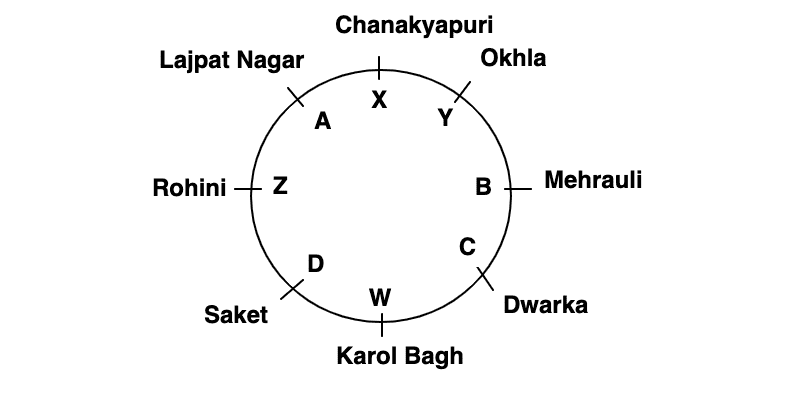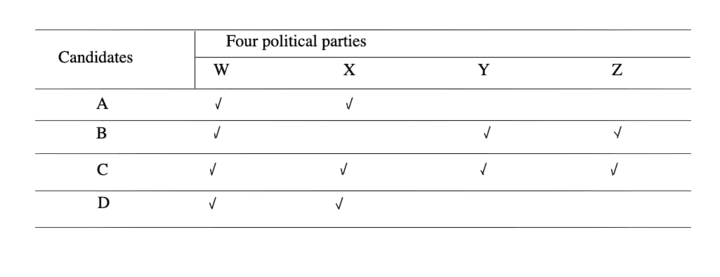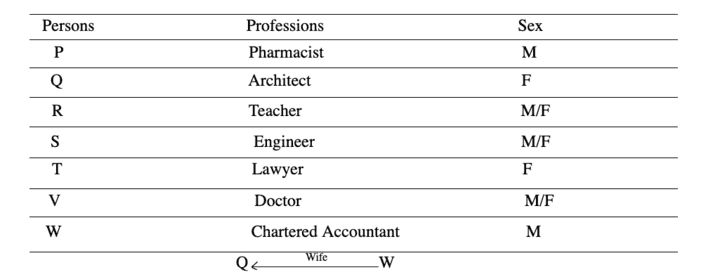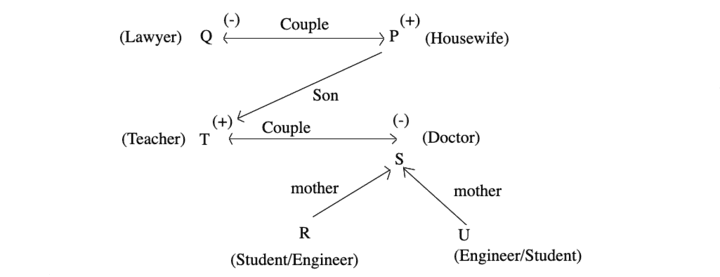Reasoning Puzzles
A puzzle is the raw information given in jumbled form in a particular order. The information given need to be arranged systematically, so that all the information can be depicted correctly.
In this chapter, we deal with the questions put in the form of puzzles involving certain number of items, (may be persons or any object). You are required to analyse the given informations, condense it in a suitable form and answer the questions asked.
The questions on puzzle test can be based on classification, placing arrangement, comparison, sequential order, based on family etc.
Types of Puzzles
There are various categories of questions based on puzzles which are as follows
Type #1
Based on Classification
Certain items belonging to different groups or possessing different qualities are given along with some clues, with the help of which you are required to group the items having common properties and analyse the given items to answer the questions accordingly.
It is advisable to solve classification based puzzle by representing the given information in form of a table.
Example 1
1. Tom, Dick, and Harry are intelligent.
2. Tom, Brown, and Jack are hard working.
3. Brown, Harry and Jack are honest.
4. Tom, Dick and Jack are ambitious.
Which of the following person is neither hard working not ambitious?
(a) Tom (b) Dick (c) Harry (d) Jack
Solution: (c) All the given information can be summarised in the tabular form as given below.

Clearly, Harry is neither hard working nor ambitious.
Type #2
Based on Seating/Placing Arrangement
In this type of puzzles, some clues regarding seating/placing arrangement (linear or circular) of some persons/objects along with additional information (like their profession, colour of wearing items, etc) are given. The candidates are required to form the proper sequence, arrange the persons using these clues and answer the questions accordingly.
Directions (Example Nos. 2-4) Read the following information carefully to answer the given questions.
Five friends A, B, C, D and E are sitting on a bench and wearing different colours shirt, i.e. blue, red, yellow, white and green (not necessarily in this order).
I. A is sitting next to B and wearing red shirt.
II. C is sitting next to D and not wearing either blue or green shirt.
III. D is not sitting with E and E is wearing blue shirt.
IV. E is on the left end of the bench.
V. C is on the second position from the right.
VI. A is on the right of B and E.
VII. B is wearing green shirt.
VIII. A and C sitting together.
IX. D is not wearing white shirt.
Example 2. Where is A sitting?
(a) Between B and D (b) Between D and C
(c) Between E and D (d) Between B and C
Example 3. What is the colour of C's shirt?
(a) Blue (b)Red
(c) White (d) Yellow
Example 4. Who is sitting in the centre?
(a) A (b) B (c) C (d) D
Solutions (Example Nos. 2-4) According to the given information, arrangement is as follows

2. (d) A is sitting between B and C.
3. (c) The colour of C's shirt is white.
4. (a) A is sitting in the centre.
Directions (Example Nos. 5-7) Study the following information carefully to answer the questions based on it.
A, B, C, D, W, X, Y and Z are sitting in a circle (But not necessary in the same order). Their faces are in the centre. W is sitting third to the left of Y. The person, who is from Dwarka is to the immediate right of W and W is not from Okhla. B is sitting fourth to the right of Z. Z is not the neighbour of Y. Neither B nor Z is an immediate neighbour of W. X is from Chanakyapuri and is sitting third to the right of the person from Dwarka. The person from Mehrauli is sitting second to the left of person from Chanakyapuri. The person from Rohini is sitting second to the left of W. A, who is from Lajpat Nagar, is sitting exactly between X and Z. The person from Saket is sitting second to the right of the person from Lajpat Nagar. C is sitting third to the left of X. Y is not from Karol Bagh.
Example 5. Who amongst the following persons belong to Okhla?
(a) Y (b) D (c) C (d) B (e) Z
Example 6. What is A's position with respect to B?
(a) Third to the right (b) Second to the right
(c) Third to the left (d) Second to the left
(e) Fourth to the right
Example 7. How many people are sitting between Z and C when counted in an anticlockwise direction from C?
(a) One (b) Two (c) Three (d) Four (e) None of these
Solutions (Example Nos. 5-7) According to the given information, arrangement is as follows

5. (a) Y belongs to Okhla.
6. (a) Position of A with respect to B is third to the right.
7. (d) When counted in an anticlockwise direction from C, then four people are sitting between Z and C.
Type #3
Conditions, Grouping and Team Formation
In this type of puzzles, conditions regarding the selection or non-selection of persons or objects with respect to one another are given. On the basis of the given information, a team is to be formed and questions are answered accordingly.
Example 8. Four political parties W, X, Y, and Z decided to set up a joint candidate for the coming parliamentary elections.
The formula agreed by them was the acceptance of a candidate by most of the parties. Four aspiring candidate A, B, C and D approached the parties for the tickets.
A was acceptable to W but not Z.
B was acceptable to Y but not X.
C was acceptable to W and Y.
D was acceptable to W and X.
When candidates B was preferred by W and Z, candidate C was preferred by X and Z and candidate A was acceptable to X but not to Y, who got the ticket?
(a) A (b) B (c) C (d) D
Solutions (c) According to the given information, arrangement is as follows.

So, C is accepted by all the four parties.
Type #4
Based on Comparison
This type of puzzles are related to comparison. You are required to analyse all the given information, arrange the data in ascending/descending sequence and then answer the questions accordingly.
It is advisable to use the notation such as greater than (>), smaller than (<) and equal to (=) properly according to given condition/information.
Directions (Example Nos. 9-12) Read the following information carefully to answer the given questions.
P, Q, R, S, T, V and W are the seven members of a family. There are three female members. Each of them has a different profession - Lawyer, Chartered Accountant (CA), Engineer, Teacher, Doctor, Architect and Pharmacist. No lady is either Pharmacist or Chartered Accountant. Each of them has a different monthly income. The Chartered Accountant earns the most. S, the Engineer earns less than V, the Doctor.
R, the Teacher, earns more than P and less than S. W's wife earns the least. T is an unmarried lady Lawyer and she earns less than P and more than only Q. The Pharmacist's income is not the lowest.
Example 9. Who earns the least?
(a) P (b) Q
(c) P or Q (d) R
Example 10. What is P's profession?
(a) Pharmacist (b)Lawyer
(c) Teacher (d) Cannot be determined
Example 11. How many members earn less than the Doctor?
(a) 2 (b) 3 (c) 4 (d) 5
Example 12. Which of the following represents the three female members of the family?
(a) PTQ (b) TRQ
(c) VTQ (d) Cannot be determined
Solutions (Example Nos. 9-12) According to the given information, arrangement is as follows

In terms of income, Q < T < P < R < S < V < W
9. (b) Q earns the least.
10. (a) P is Pharmacist.
11. (d) V is Doctor and Q, T, P, R and S earn less than V.
12. (d) The females are Q, T and one from R, S and V.
Type #5
Sequential Order to Things
In this type of puzzles, some clues are given regarding the order of occurrence of certain events. The candidate is required to analyse the given information, frame the right sequence and then answer the questions accordingly.
Directions (Example Nos. 13-14) Study the following information carefully to answer the given questions.
Seven people J, K, L, M, N, O and P have to attend a seminar on seven different days of the same week starting from Monday and ending on Sunday, but not necessarily in the same order. K has to attend a seminar on Wednesday. Only one person has to attend a seminar between K and P. J attends a seminar immediately after P.
The number of people who have to attend a seminar before J is same as who have to attend a seminar after L. Only one person has to attend a seminar between L and M. O has to attend a seminar immediately after M.
Example 13. On which of the following days does N have to attend a seminar?
(a) Sunday (b) Thursday
(c) Saturday (d) Wednesday
(e) Tuesday
Example 14. As per the given arrangement, four of the following five are alike in a certain way and so form a group. Which one of the following does not belong to the group>
(a) M-Friday (b) M-Wednesday
(c) O-Sunday (d) O-Thursday
(e) J-Wednesday
Solutions (Example Nos. 13-14) According to the given information, arrangement is as follows

13. (a) N has to attend a seminar on Sunday.
14. (c) Except option (c), in all other options, then given day is either the previous day or the next day of the day on which the given person has to attend a seminar.
Type #6
Based on Family Problems
In this type of puzzles, some clues are provided regarding relationship amongst different members of a family, together with their professions, qualities, colours, dresses etc. You have to analyse the whole information and then answer the given questions accordingly.
Example 15. P, Q, R, S, T and U are 6 members of family in which there are two married couples. T, a teacher, is married to a doctor who is mother of R and U. Q, the lawyer, is married to P. P has one son and one grandson. Of the two married ladies one is a housewife. There is also one student and one male engineer in the family.
Which of the following is true about the granddaughter of the family.
(a) She is a lawyer
(b) She is an engineer
(c) She is a student
(d) She is a doctor
Solutions (c) According to the given information, arrangement is as follows

So, the granddaughter of the family is a student and either R or U is a student.
Type #7
Some Miscellaneous Puzzles
In this type of puzzles, some mixed clues regarding three or more conditions of persons/objects are given. It is required to analyse this mixed information with respect to different conditions and classify the objects accordingly to answer the questions asked.
Directions (Example Nos. 16-17) Read the following information carefully and answer the questions mentioned below.
I. Five friends Amar, Kapil, Sarvesh, Rohan and Nagesh put on five shirts of different colours, i.e. Red, Yellow, Blue, White and Green, while they were going to attend a party. These colours are not in order.
II. They have different hobbies are reading, playing, outing, singing and writing.
III. Kapil, who likes singing, does not wear yellow shirt. Sarvesh wears red shirt and the does not like reading or writing. Nagesh likes playing and he does not wear blue or yellow shirt. Amar likes writing and Rohan does not wear yellow or green shirt.
Example 16. What is the colour of Kapil's shirt?
(a) White (b) Green
(c) Blue (d) Data inadequate
Example 17. Who likes reading?
(a) Rohan (b) Amar
(c) Kapil (d) Data inadequate
Solutions (Example Nos. 16-17) According to the given information, arrangement is as follows

16. (d) The colour of Kapil's shirt may be either blue or white or green Hence, data is inadequate to answer the question.
17. (a) Rohan likes reading.
LearnFrenzy provides you lots of fully solved "Reasoning Puzzles" Questions and Answers with explanation.
